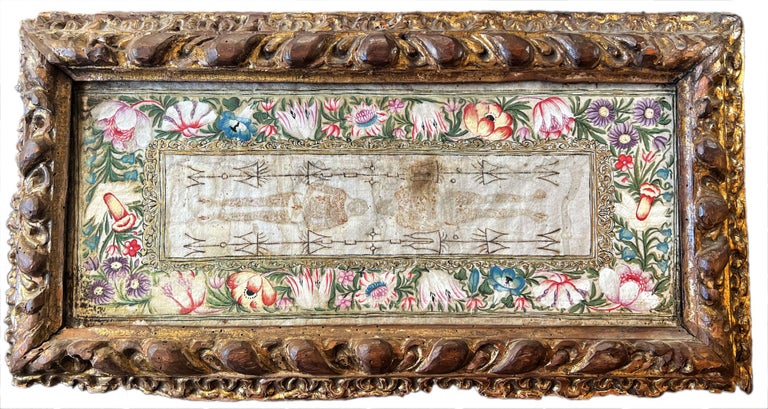
A painting of the Shroud of Turin on silk. [Piedmont, 17th or early 18th century].
A painting on silk in gouache and ink, including gold ink, measuring 447 x 188 mm., at center the long rectangular image of the Turin shroud with the faint impression of the body seen from front and back in reddish-brown ink, flanked by two rows of lines linking triangles and circles (representing the burned areas along the folds and triangular patches sewn onto the shroud by Poor Clares nuns after it was damaged by fire in 1532), within an ornate volute “frame” in black and gold ink, set within a wide border of multi-colored flowers and flowering plants, framed in a double black ink rule. Condition: approximately one-inch square stain within shroud area, traces of dampstaining, a couple of small holes to floral border, darkening and fraying along edges of the silk (hidden by frame), dark spotting to corners. Professionally mounted on linen stretched over a wooden backing, and preserved in its original giltwood molded frame (partly damaged with losses to outer edge) and contemporary hand-blown glass (the painting was removed from the frame for examination and photography). ***
An anonymous popular painting of the Shroud of Turin, venerated by Catholics as the shroud which wrapped and received an imprint of Christ’s crucified body. Among Catholic relics the Turin Shroud holds pride of place as one of the most fertile inspirations for popular artistic creation. From its first mention in the 14th century, votive objects, paintings, prints and embroideries of the shroud proliferated, catering to the need of the faithful to hold a “piece” of this their most treasured relic in their homes. Most of these homespun works have perished.
The yellowed linen sheet known in Italy as the Sindone, measuring 4.42 meters long and 1.13 meters in width, bears the faint image of a man, seen from front and back, bearing marks of torture compatible with the description of Christ’s crucificion. The earliest description of the shroud dates to the 14th century, when it was apparently discovered in Lirey, Champagne. In the 15th century it was sold to the Duke of Savoy, who moved it to Chambéry, and, after various peregrinations, largely due to wars, the shroud found a permanent home in 1706 in the Cathedral of Turin. The closely guarded shroud is periodically exhibited in ceremonial ostensioni, most of which are now televised. As both an important Catholic relic and the mascot of the proud city of Turin, capital of Savoy, the Sindone has been the object of outsized attention. Modern scientific analyses including Carbon 14 tests have dated the textile to ca. 1260-1390, although the exact source of the eerie markings has not been elucidated. This has not discouraged the practitioners of the pseudoscience known as “Sindonologia” from pursuing their ”investigations,” generation after generation.
Some of the art surrounding the Sindone was produced officially, on the periodic occasions of the Ostensioni, but much of the popular art representing the shroud was a natural outgrowth of private local veneration of the beloved object. The present painting imitates the vogue in seventeenth-century Piedmont for embroidered examples using similar iconography, in which the outer embroidered floral border enclosed a painted or engraved shroud (several are reproduced in La Sindone e sue immagine, pp. 51-57). “Of Flemish origin, the idea of inserting a sacred image into a wreath of flowers appears in Piedmont by the first decades of the seventeenth century” (op. cit., p. 167). “During the 17th and 18th centuries in particular, small pictures were produced in which the Holy Linen was represented on silk, painted or printed, surrounded by floral borders, containing garlands of flowers, such as tulips, peonies, roses, dahlias, carnations and hyacinths ... [which were] completely embroidered in polychrome silk and gold and silver thread ... These objects were intended for private devotion and were often the work of female embroiderers, whether laywomen or nuns. At the time the manual labor and concentration required to produce such works was considered favorable for cultivating the proper state of mind for meditation and prayer on the theme of Christ’s Passion...” (ibid., p. 49, my transl.).
While paintings and engravings of the shroud were indeed often produced on silk, materially reflecting the venerated object, I have located no other examples, either in the literature or among the artifacts exhibited in Turin’s Museo della Sindone, using this iconography, in which both the central shroud and the floral border were painted. Here the gilt and painted border surrounding the shroud no doubt deliberately mirrors the contemporary giltwood frame.
Cf. La Sindone e sue immagine, catalogue of an exhibition held at the Palazzo Madama, September 2018 - Jan. 2019 (PDF available online). Item #4144
No longer available
Status: On Hold
